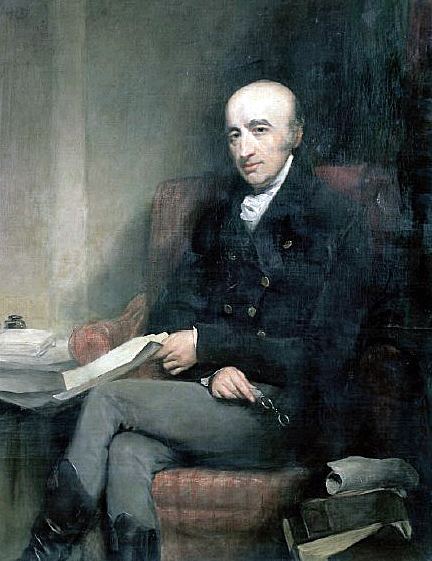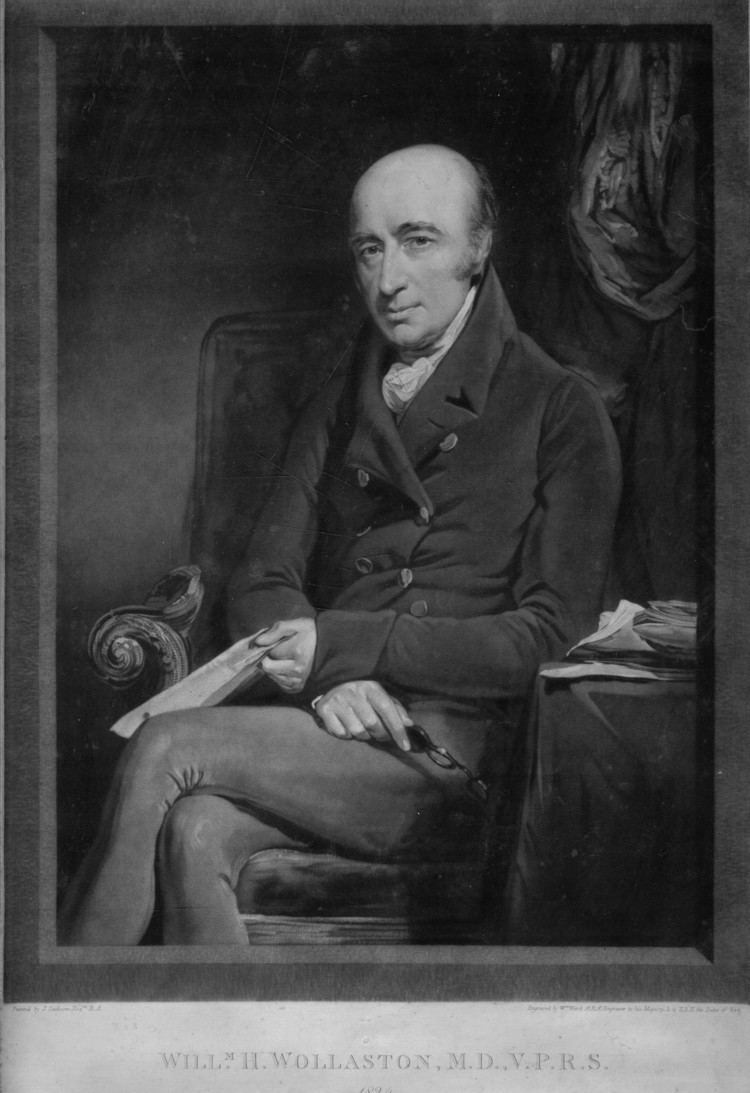Nationality United Kingdom | Role Chemist Name William Wollaston | |
 | ||
Books The Bakerian Lecture: On a Method of Rendering Platina Malleable Similar People | ||
Education University of Cambridge | ||
William Hyde Wollaston
William Hyde Wollaston (; 6 August 1766 – 22 December 1828) was an English chemist and physicist who is famous for discovering the chemical elements palladium and rhodium. He also developed a way to process platinum ore into malleable ingots.
Contents

Biography

Wollaston was born in East Dereham, Norfolk, the son of the priest-astronomer Francis Wollaston (1737–1815) and his wife Althea Hyde. The family, which included 17 children, was financially well-off and were part of an intellectually stimulating environment. Wollaston was educated at Charterhouse School and Gonville and Caius College, Cambridge: in 1793 he obtained a doctorate in medicine from Cambridge University, and was a fellow of his college from 1787 to 1828.
He worked as a physician in rural areas between 1793 and 1797, then moved to London. During his studies, Wollaston had become interested in chemistry, crystallography, metallurgy and physics. In 1800, after he had received a large sum of money from one of his older brothers, he left medicine. He concentrated on pursuing his interests in chemistry and other subjects outside his trained vocation.
He was elected a Fellow of the Royal Society in 1793, where he became an influential member. He served as president in 1820. In 1822 he was elected a Foreign Honorary Member of the American Academy of Arts and Sciences.
Wollaston never married. He died in London in 1828 and was buried in Chislehurst, England.
Work
After having established a partnership with Smithson Tennant in 1800 in order to produce and sell chemical products, Wollaston became wealthy by developing the first physico-chemical method for processing platinum ore in practical quantities. He held the details of the process secret until near his death and made huge profits for about 20 years by being the only supplier in England of the product which had many of the same qualities as gold, but was much cheaper.
Chemical analysis related to the process of purifying platinum led Wollaston to discover the elements palladium (symbol Pd) in 1802 and rhodium (symbol Rh) in 1804.
Anders Gustav Ekeberg discovered tantalum in 1802; however, Wollaston declared it was identical with niobium (then known as columbium). Later Heinrich Rose proved in 1846 that columbium and tantalum were indeed different elements and he renamed columbium "niobium". (Niobium and tantalum, being in the same periodic group, are chemically similar.)
The mineral wollastonite was later named after Wollaston for his contributions to crystallography and mineral analysis.
Wollaston also performed important work in electricity. In 1801, he performed an experiment showing that the electricity from friction was identical to that produced by voltaic piles. During the last years of his life he performed electrical experiments, such as the accidental discovery on electromagnetic induction 10 years prior to Faraday, that would pave the way to the eventual design of the electric motor. Controversy erupted when Michael Faraday constructed the first working electric motor and hastily published his results without acknowledging Wollaston's previous work. Wollaston, however, saw nothing wrong with Faraday's action. Wollaston also invented a battery that allowed the zinc plates in the battery to be raised out of the acid, so that the zinc would not be dissolved as quickly as it would if it were in the battery all the time.
His optical work was important as well, where he is remembered for his observations of dark Fraunhofer lines in the solar spectrum (1802), which eventually led to the discovery of the elements in the Sun. He invented the camera lucida (1807), the reflecting goniometer (1809), and the Wollaston prism. He also developed the first lens specifically for camera lens called Wollaston's meniscus lens, or just meniscus lens, in 1812. The lens was designed to improve the image projected by the camera obscura. By changing the shape of the lens, Wollaston was able to project a flatter image, eliminating much of the distortion that was a problem with many of that day's biconvex lenses.
Wollaston also devised a cryophorus, "a glass container containing liquid water and water vapor. It is used in physics courses to demonstrate rapid freezing by evaporation." He used his Bakerian lecture in 1805, On the Force of Percussion, to defend Gottfried Leibniz's principle of vis viva, an early formulation of the conservation of energy.
Wollaston's attempt to demonstrate the presence of glucose in the blood serum of diabetics was unsuccessful due to the limited means of detection available to him. His 1811 paper "On the non-existence of sugar in the blood of persons labouring under diabetes mellitus" concluded that sugar must travel via lymphatic channels from the stomach directly to the kidneys, without entering the bloodstream. Wollaston supported this theory by referring to the thesis of a young medical student at Edinburgh, Charles Darwin (1758–1778), "Experiments establishing a criterion between mucaginous and purulent matter. And an account of the retrograde motions of the absorbent vessels of animal bodies in some diseases." This Charles Darwin was the eldest son of Erasmus Darwin and not his more famous nephew, Charles Robert Darwin.
Wollaston prophetically foretold that if once an accurate knowledge were gained of the relative weights of elementary atoms, philosophers would not rest satisfied with the determination of mere numbers, but would have to gain a geometrical conception of how the elementary particles were placed in space. Jacobus Henricus van 't Hoff's La Chimie dans l'Espace was the first practical realisation of this prophecy.
Wollaston was part of a royal commission that recommended adoption of the imperial gallon in 1814. He served on the government's Board of Longitude between 1818 and 1828 and was part of royal commission that opposed adoption of the metric system (1819).
Wollaston was too ill to deliver his final Bakerian lecture in 1828 and dictated it to Henry Warburton who read it on 20 November.
